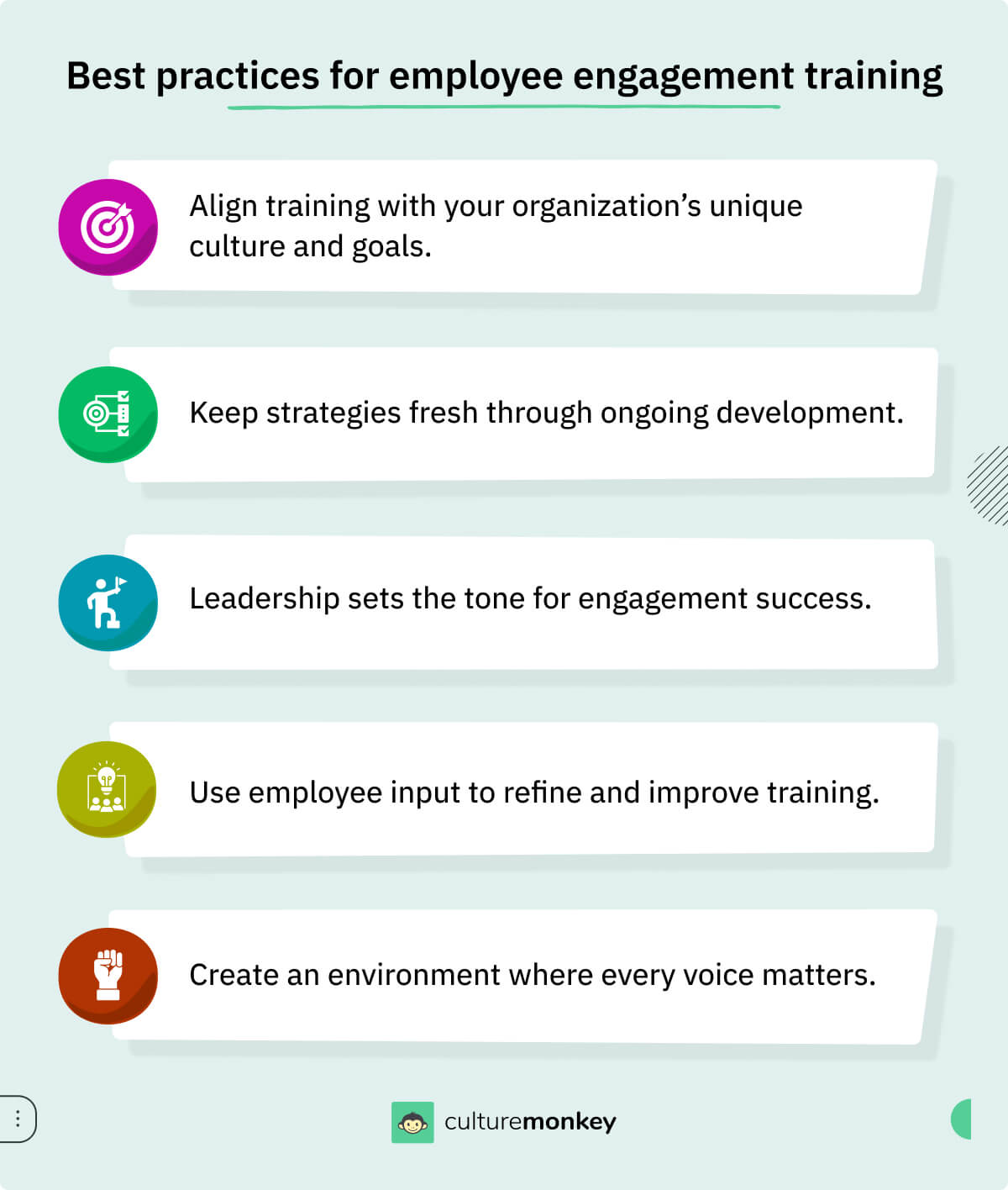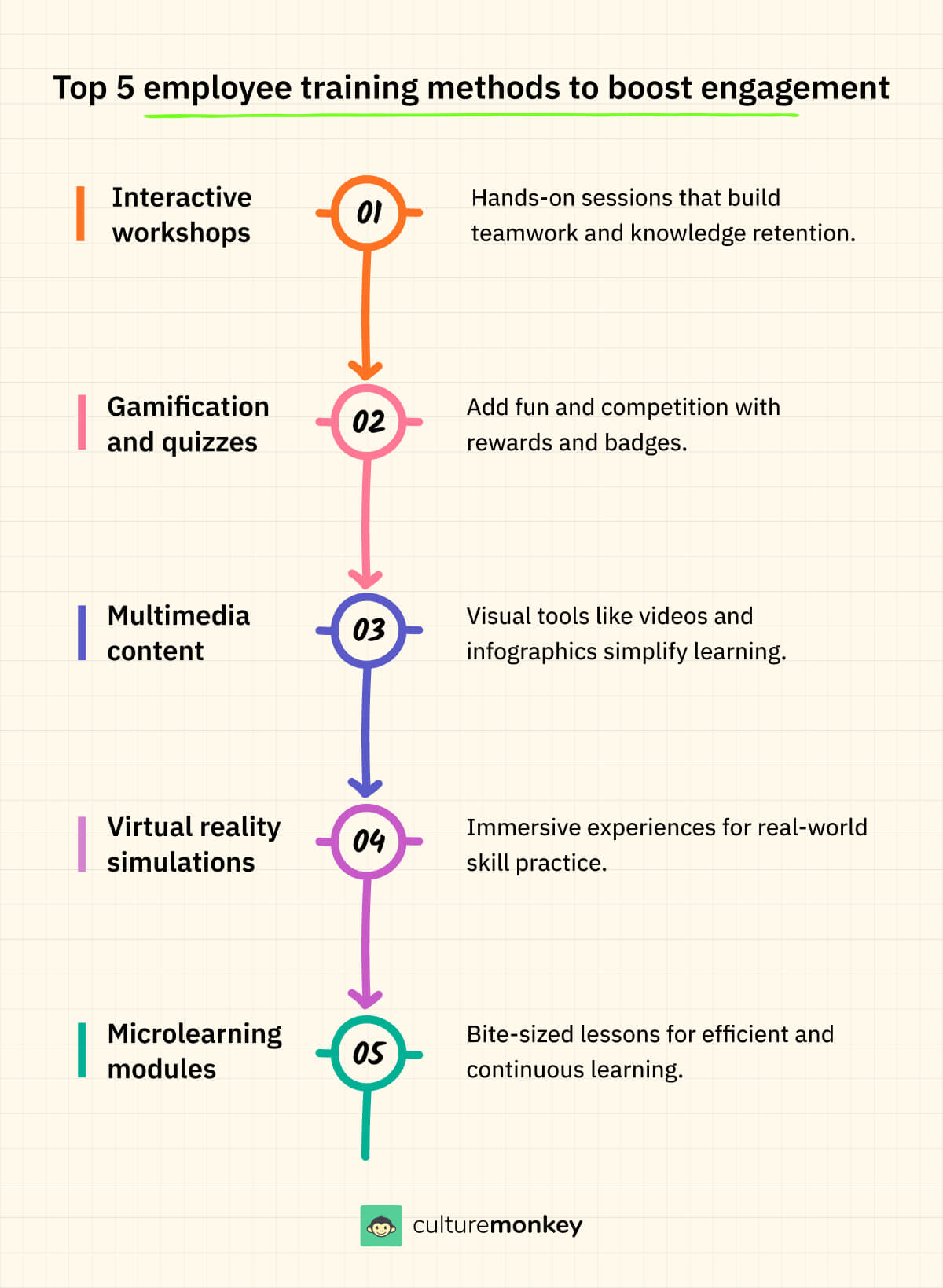What is employee engagement training: A complete guide

In today's fast-paced work environment, keeping your team motivated and connected is a game-changer. This guide is your passport to understanding what employee engagement training is all about and how it can revamp your workplace dynamics.
Employee engagement training isn't just a buzzword—it's a powerhouse strategy that can take your business and team from 'meh' to 'wow'. Let's embark on this journey together, uncovering the secrets behind creating a workplace where everyone is not just present, but fully invested and thriving.
Blog Highlights


What is employee engagement training?

Employee engagement training is like the secret sauce of a thriving workplace. It's all about equipping your team with the skills and knowledge they need to be not just active members of the workforce but enthusiastic, motivated, and deeply connected ones. In essence, it's the art and science of getting your employees to love what they do and where they do it.
At its core, this form of training is about enhancing the emotional and intellectual commitment of your workforce to their roles and the organization as a whole. It involves teaching strategies, communication techniques, and leadership skills to create a workplace where people feel motivated, valued, and aligned with company goals.
To put it simply, training programs of this sort refer to training your team to be more than just workers; it's about transforming them into passionate, engaged advocates for your company.
Benefits of employee engagement training you should know

Training isn't just a nice-to-have; it's a game-changer that comes with numerous benefits:
Increased productivity
Engagement training is a turbocharger for productivity. When your team feels connected and motivated, they go the extra mile, resulting in a 21% increase in productivity, according to Gallup.
Better retention rates
A well-engaged group of employees is a loyal one. Organizations with robust engagement programs experience less turnover, saving businesses significant costs in recruitment and training.
Enhanced innovation
Engaged employees are more likely to contribute creative ideas. They're 20% more innovative, according to a study by the corporate leadership council.



Employees engage with employers and brands when they’re treated as humans worthy of respect.
Founder
TalentCulture
Healthier work environment
Reduced stress, fewer sick days, improved mental health, and overall well-being—these are the results of higher employee engagement. A study by the American Psychological Association found that employees and workers who are engaged report lower stress levels.
Boosted profits
Engaged employees directly impact the bottom line. Companies with highly engaged employees achieve 21% higher profitability.
Attracting top talent
When your organization is known for its excellent employee engagement, you become a magnet for top-tier talent looking for a workplace that values and nurtures its people.
Positive company culture
Training fosters a vibrant and inclusive company culture. When people are happy and engaged, they create a positive, collaborative atmosphere that radiates throughout the organization.
Reduced workplace conflicts
Employees who are engaged tend to resolve conflicts more amicably. This translates to smoother teamwork and a more harmonious work environment.
Increased employee satisfaction
When employees feel their voices are heard and their contributions valued, job satisfaction soars. Happier employees mean a happier workplace.
These benefits are not just theoretical; they translate into tangible improvements that can transform your organization into a dynamic, thriving, and successful entity.
Employee engagement training topics

Employee engagement training covers a wide range of essential program topics to create a holistic approach to building a motivated workforce:
- Communication skills: Teaching effective communication fosters understanding and trust among team members.
- Recognition and appreciation: Showing employees that their efforts are noticed and valued by business leaders is crucial for engagement.
- Leadership development: Training managers to lead by example and inspire their teams is a cornerstone of all employee engagement training initiatives.
- Feedback and performance reviews: Providing access to constructive feedback and setting goals empowers employees to improve their business outcomes.
- Work-life balance: Ensuring that employees maintain and develop a healthy balance between work and personal life is key to long-term engagement.
- Team building: Encouraging team bonding and support for collaboration helps create a supportive work environment.
- Inclusivity and diversity: Promoting an inclusive workplace fosters a sense of belonging among employees from diverse backgrounds.
- Emotional intelligence: Training on emotional intelligence helps employees and managers navigate interpersonal relationships effectively.
- Stress management: Equipping employees with tools to manage stress ensures a healthy and engaged space.
- Adaptability and change management: Teaching employees to embrace change and adapt to new situations is crucial to succeed in today's fast-paced world.
- Continuous learning and development: Providing opportunities for ongoing learning and skill development keeps employees engaged and motivated to grow within the organization.
- Employee well-being initiatives: Implementing programs and policies that support physical, mental, and emotional well-being contributes to overall engagement and retention.
Key areas of focus in employee engagement training for managers

Employee engagement training for managers is pivotal in building a motivated and connected workforce while enhancing the overall employee experience. To foster a culture of trust and collaboration, managers must develop skills in key areas that directly impact employee engagement. Below are five critical directives that ensure managers lead with purpose and drive engagement effectively.
- Appreciation: Managers should learn how to recognize and celebrate individual and team achievements consistently. Genuine appreciation boosts morale and reinforces positive behaviors, making employees feel valued. Training in appreciation strategies ensures that recognition is timely, inclusive, and meaningful.
- Feedback: Providing constructive, actionable feedback is essential for employee growth and engagement. Managers must master delivering feedback that motivates rather than discourages, aligning it with personal and organizational goals. Training in feedback methods equips managers with tools to nurture a culture of continuous improvement.
- Connection: Building strong interpersonal connections fosters trust and loyalty within teams. Managers should undergo training to improve empathy, emotional intelligence, and rapport-building skills. This enables them to bridge gaps, create inclusive spaces, and address employee concerns effectively.
- Information Sharing: Transparent communication ensures that employees are aligned with the organization's goals and values. Managers must be trained to share information effectively, ensuring clarity without overwhelming or withholding critical details. Such skills foster trust and empower employees to make informed decisions.
- Training and Development: Offering opportunities for skill enhancement through personalized development plans motivates employees to stay engaged. Managers should be trained to identify team skill gaps and collaborate on growth-oriented initiatives. Supporting continuous learning ensures employees feel invested in and valued by their organization.
The value of employee engagement training for managers

Managers play a pivotal role in both employee motivation and engagement. They are the bridge between the organization's goals and the team's performance. Here's why training is indispensable for managers:
- Improved leadership skills: It equips managers with the skills to lead with empathy, inspire their teams, and set a positive example.
- Enhanced communication: Managers learn to communicate effectively, ensuring their team understands the company's vision and their role within it.
- Boosted morale: Engaged managers naturally influence their teams, leading to higher morale and motivation among employees.
- Better performance management: Training helps managers provide constructive feedback, set goals, and track employee progress effectively.
- Reduced turnover: Engaged managers are more likely to retain top talent by fostering a supportive and satisfying work environment.
- Conflict resolution: Managers become adept leaders at building trust, resolving conflicts, and maintaining a harmonious workplace.
- Empowerment through delegation: Managers learn how to effectively delegate tasks and responsibilities, empowering employees and fostering a sense of ownership and accountability.
- Promotion of diversity and inclusion: Training equips managers with the tools to promote diversity and inclusion within their teams, creating an environment where all employees feel valued and respected.
In essence, employee engagement training for managers is an investment in leadership excellence, resulting in a motivated workforce and a more prosperous organization.
Employee engagement training best practices

Let’s explore some best practices that can turn your workforce into a motivated, collaborative dream team.
Tailored approach
Customize training courses to address specific organizational needs, considering the unique culture and challenges your company faces. This approach ensures that engagement strategies align seamlessly with your business goals.
Continuous learning
Implement ongoing training programs to develop and keep employee engagement strategies fresh and relevant. By promoting continuous learning, you foster an environment where employees are always growing and adapting.
Top-down commitment
Ensure leadership is fully committed to employee engagement initiatives, setting an example for the entire organization. When leadership is actively engaged, it sends a powerful message to the entire workforce.
Feedback loops
Establish mechanisms for employees to provide feedback on courses and course engagement, and suggest improvements to engagement efforts. Feedback loops create a culture of openness and improvement.
Inclusivity
Foster an inclusive environment where everyone feels heard, valued, and engaged. Inclusivity is the cornerstone of a workplace where all employees can thrive and actively contribute to the organization's success.
Remember – embracing these best practices ensures that employee engagement training is not just a one-time event but a continuous journey towards a motivated, committed workplace.

5 Employee training methods that increase engagement

Engaging employee training methods are key to ensuring employees remain motivated and attentive throughout their learning journey. By leveraging innovative approaches, organizations can create learning experiences that foster engaged teams and drive meaningful results. Here are five proven methods to boost employee engagement through training and development.
- Interactive workshops: Workshops that encourage hands-on participation foster a collaborative learning environment. Activities like group discussions, role-playing, and problem-solving simulations keep employees actively involved. This approach ensures that employees retain knowledge while building teamwork skills.
- Gamification and quizzes: Integrating gamification elements such as rewards, badges, and leaderboards adds a competitive and fun element to training. Quizzes that reinforce learning outcomes help employees test their knowledge in an engaging way. These strategies make training exciting and foster healthy competition among staff.
- Multimedia content: Incorporating videos, infographics, and animations creates visually stimulating content that caters to diverse learning styles. Multimedia makes complex concepts easier to understand, keeping training relevant and fresh. This method also enhances retention rates by appealing to both auditory and visual learners.
- Virtual Reality simulations: Using virtual reality (VR) creates immersive training experiences that replicate real-world scenarios. This method allows employees to practice skills in a safe and controlled environment. VR simulations are especially effective for roles requiring hands-on technical expertise or complex problem-solving.
- Microlearning modules: Short, focused training modules delivered in bite-sized formats are ideal for busy employees. These modules target specific skills or concepts, ensuring efficient learning without overwhelming participants. Microlearning also promotes continuous learning and development at a manageable pace.
How can employee engagement training benefit both employees and the organization?
Employee engagement training offers numerous benefits for both employees and organizations, fostering a mutually beneficial relationship that contributes to overall success. Here's how:
For Employees:
- Enhanced skill development: Employee engagement training provides opportunities for skill enhancement, including communication, leadership, and problem-solving skills. This allows employees to grow both personally and professionally, empowering them to take on new challenges and responsibilities within the organization.
- Increased job satisfaction: Training programs that prioritize employee engagement demonstrate a commitment to individual growth and development. This fosters a sense of value and appreciation among employees, leading to increased job satisfaction and a higher level of commitment to the organization.
- Career advancement opportunities: By participating in engagement training, employees gain the skills and knowledge needed to advance their careers within the organization. This can include opportunities for promotion, salary increases, and expanded job responsibilities, providing a clear path for professional growth and advancement.
- Improved work-Life balance: Employee engagement training often includes sessions on stress management, work-life balance, and well-being. By equipping employees with tools and strategies to manage their workload effectively and prioritize their personal lives, organizations can support a healthier and more balanced lifestyle for their employees.
For the Organization:
- Higher employee retention rates: Engaged employees are more likely to remain with the organization long-term, reducing turnover costs and increasing stability within the workforce. Employee engagement training helps create a positive work environment where employees feel valued, respected, and motivated to stay.
- Increased productivity and performance: Engaged employees are more productive, innovative, and committed to achieving organizational goals. By investing in engagement training, organizations can boost overall performance and competitiveness in the marketplace.
- Enhanced employee morale and loyalty: Training programs that prioritize employee engagement contribute to a positive organizational culture characterized by high morale, strong team dynamics, and a sense of loyalty among employees. This fosters a supportive and collaborative work environment where employees feel connected to the organization's mission and values.
- Improved customer satisfaction: Engaged employees who feel motivated and empowered are more likely to deliver exceptional customer service. This can lead to increased customer satisfaction, loyalty, and positive word-of-mouth referrals, ultimately driving business growth and success.
How to tailor employee engagement training for remote and hybrid teams

Adapting employee engagement training for remote and hybrid teams is crucial in today’s flexible work environment. Effective learning experience ensures that employees remain connected, motivated, and aligned with organizational goals, regardless of location. Below are strategies to design impactful employee engagement programs tailored for dispersed teams.
- Leverage digital collaboration tools: Incorporate tools like Slack, Microsoft Teams, and Zoom to foster interactive training sessions. These platforms enable seamless communication and collaboration among remote participants, helping to build engaged teams. Digital tools also create opportunities for real-time feedback and engagement during training.
- Focus on inclusivity across time zones: Schedule training sessions that accommodate employees in different time zones to ensure fair participation. Record sessions for those unable to attend live, promoting inclusivity. This approach highlights the organization’s commitment to equal access to learning and development.
- Utilize multimedia learning content: Offer a blend of videos, podcasts, and interactive quizzes to make training engaging and accessible. Multimedia content ensures that learning materials cater to diverse preferences and remain available on-demand. This flexibility boosts participation and retention among remote and hybrid employees.
- Promote peer-to-peer learning: Encourage team members to share their expertise and experiences through virtual engagement workshops for staff. Peer-led training sessions build trust, collaboration, and a sense of community. These sessions also provide practical, real-world insights that enhance learning outcomes.
- Incorporate feedback loops: Use surveys and virtual feedback forms to gather insights on training effectiveness. Act on feedback to refine training content and methods for remote and hybrid teams. Continuous improvement demonstrates a commitment to keeping training engaging, relevant, and impactful.
How to motivate employees to attend training
Motivating employees to attend training is essential for fostering engagement and building a skilled, adaptable workforce. A well-structured training program that aligns with employee goals and organizational objectives can make learning appealing and impactful. Here are practical strategies to encourage participation in training initiatives.
- Highlight career benefits: Emphasize how the training program contributes to career advancement and skill enhancement. Demonstrating its relevance to individual growth fosters enthusiasm and commitment. Employees are more likely to attend when they see direct benefits to their professional development.
- Offer flexible learning options: Provide diverse learning formats like online courses, workshops, or self-paced modules. Flexible options ensure employees can integrate training into their schedules without disrupting work-life balance. This approach caters to different learning preferences, increasing attendance rates.
- Incorporate interactive elements: Make training engaging and relevant by including hands-on activities and real-world scenarios. Techniques like role-playing, problem-solving tasks, and group discussions enhance learning experiences. Interactive sessions encourage employees to actively participate and apply what they learn.
- Create a supportive environment: Encourage managers to promote training and provide necessary support. Positive reinforcement and open communication about training objectives can build trust and interest. When leadership champions learning, employees feel more inclined to participate.
- Recognize and reward participation: Incentivize training attendance with recognition, certifications, or tangible rewards. Employees appreciate acknowledgment of their efforts, which reinforces a culture of continuous learning. This motivates individuals to prioritize training and engage fully.
Metrics to measure and improve employee engagement training KPIs

Tracking metrics is essential for improving employee and engagement levels. Here are some key performance indicators (KPIs) that can help you measure and then boost engagement -
- Employee satisfaction scores: Conduct pulse surveys and employee engagement workshops to gauge satisfaction levels post-training. Assess how well employees feel their needs are addressed through the training. High scores indicate alignment with employee expectations, fostering retention and engagement.
- Retention rates: Analyze turnover rates before and after implementing the employee engagement training program. A decrease in turnover signals improved job satisfaction and organizational loyalty. Use insights to refine training content and focus areas.
- Productivity metrics: Track productivity levels to measure training's impact on task efficiency and output quality. Enhanced productivity reflects the training's relevance to job roles. Regularly review data to keep training engaging, relevant, and fresh.
- Feedback and idea uptake: Monitor the volume and quality of employee suggestions post-training. Increased feedback and innovative ideas signify higher engagement levels. Use this data to validate the program's success and encourage a culture of collaboration.
- Performance metrics: Evaluate individual and team performance improvements tied to specific training outcomes. Metrics such as project completion rates and error reductions provide actionable insights. This data helps tailor future training modules to enhance effectiveness.

Track the Right Metrics to Drive Engagement
Discover essential metrics to evaluate training programs and improve employee engagement effectively.
7 Employee engagement training exercises

Employee engagement is the secret sauce for a thriving and productive workplace. It's not just about the work employees do but how they feel about it. Engaged employees are enthusiastic, committed, and motivated, and they contribute their best to the organization.
So, how do you nurture engagement?
Through training exercises that foster a positive work environment and promote strong relationships among your team.
- Peer appreciation: Encourage employees to publicly appreciate their colleagues' efforts.
- Role reversal: Managers and employees switch roles for a day to better understand each other's challenges.
- Storytelling workshops: Share stories of personal and professional growth to inspire, motivate, and connect.
- Goal-setting: Engage teams in setting achievable, motivating goals together.
- Conflict resolution simulations: Train employees in resolving workplace conflicts effectively.
- Mindfulness and stress reduction: Teach relaxation techniques to manage stress.
- Collaborative projects: Encourage cross-functional teams to work on projects beyond their usual roles.
What are some common challenges in employee engagement, and how can training address them?
Common challenges in employee engagement can arise from various factors within the workplace environment. However, effective training initiatives can address these challenges head-on, fostering a culture of engagement and motivation.
Here are some common challenges and how training can help mitigate them:
- Lack of communication: Poor communication between employees and management can hinder engagement. Training programs can teach effective communication strategies, including active listening, feedback techniques, and transparent communication channels, to ensure that messages are conveyed clearly and openly throughout the organization.
- Limited recognition and appreciation: Employees may feel undervalued or unappreciated if their efforts go unnoticed. Training can educate managers on the importance of regular recognition and appreciation, providing them with tools and techniques to acknowledge and reward employee contributions effectively.
- Inadequate leadership: Weak or ineffective leadership can undermine employee engagement efforts. Leadership development training can empower managers with the skills and knowledge needed to lead by example, inspire their teams, and create a positive work environment conducive to engagement and motivation.
- Insufficient feedback and support: Without regular feedback and support, employees may feel disconnected from their work and uncertain about their performance. Training programs can emphasize the importance of ongoing feedback and provide managers with the tools to deliver constructive feedback, set goals, and support employee development effectively.
- Work-life imbalance: Employees who feel overwhelmed by their workload or lack of work-life balance may struggle to stay engaged. Training on work-life balance and stress management can help employees prioritize their responsibilities, set boundaries, and maintain a healthy balance between their professional and personal lives.
- Lack of opportunities for growth: Employees who perceive limited opportunities for career advancement or skill development may become disengaged. Training initiatives that prioritize continuous learning and development can provide employees with opportunities to grow their skills, expand their knowledge, and advance their careers within the organization.
- Resistance to change: Change can be unsettling for employees, leading to resistance and decreased engagement. Change management training can help employees understand the reasons behind organizational changes, navigate transitions effectively, and adapt to new ways of working with confidence and resilience.
Employee engagement training examples at an engaged workforce

Disney
Disney is renowned for its commitment and creativity to creating a magical experience for both guests and employees. The Disney Institute's "Approach to Employee Engagement" is a shining example of how they make this happen.
This training isn't about teaching magic tricks; it's about instilling Disney's core values into every employee. Participants learn how to foster a culture where employees feel not just connected to the company, but part of something truly special. The focus is on creating a workplace where even the most routine tasks are performed with enthusiasm, confidence and a sense of purpose.
Zappos
Zappos, the online retail giant, has made a name for itself through exceptional customer service and a unique company culture. Their "Culture Camp" training program immerses employees in the Zappos ethos.
Participants experience firsthand the company's commitment to delivering happiness. They learn about Zappos' core values, which emphasize customer service and personal growth.
By integrating culture into their training, Zappos ensures that every employee understands and aligns with their mission. This results in a workplace where employees are not just coworkers but brand ambassadors who live and breathe the company's values.
Salesforce
Salesforce, a leader in cloud-based customer relationship management, understands the importance and benefit of continuous learning. They utilize "Trailhead," an innovative learning platform, to provide their employees with access to ongoing education and development opportunities.
Salesforce's approach is all about fostering a culture of growth and self-improvement. Trailhead offers a wide range of courses, from technical skills to soft skills, allowing employees to customize their learning paths.
By providing such a valuable resource, Salesforce ensures that employees are engaged and always striving to improve. This translates into a workplace where personal and professional development are actively encouraged.
In each of these examples, training goes beyond just ticking boxes; it's about creating a workplace culture that not only engages employees but also empowers them to be brand advocates and champions of the company's mission.
Top 3 employee engagement training programs
Selecting the right employee engagement training program can significantly impact how effectively your organization fosters a motivated and connected workforce. The best programs equip participants with actionable tools, techniques, and strategies to drive engagement and create a thriving workplace culture. Below are three top-rated training programs tailored to meet the diverse needs of organizations looking to enhance employee engagement strategies.
1. Gallup
Gallup’s two-day virtual training program is designed for Engagement Champions to create an engaging workplace culture. It teaches participants how to advocate for engagement, support managers, and foster high-performing teams. The course combines live sessions, interactive tools, and independent assignments for practical learning.
Participants learn to guide managers, promote engagement initiatives, and facilitate developmental conversations. The program also includes a half-day module for training managers to implement engagement strategies. It is ideal for HR professionals, leaders, and managers aiming to champion workplace engagement.
Key Features:
- Mode: Virtual with live sessions and interactive tools.
- Cost: $3,000 per participant.
- Duration: Two days
2. eCornell - Strategic engagement course
eCornell’s Strategic Engagement Course helps HR leaders align employee engagement strategies with organizational goals. Over two weeks, participants learn to evaluate engagement efforts, analyze survey data, and create actionable strategies for driving performance. Guided by Cornell faculty, the program provides practical tools to address disengagement and implement meaningful improvements.
The course emphasizes real-world applications, focusing on how engagement behaviors influence outcomes and identifying key areas for change. Participants leave equipped to design tailored engagement plans that integrate seamlessly with organizational strategies.
Key Features:
- Mode: Fully online with instructor-led sessions.
- Cost: Pricing available upon inquiry.
- Duration: Two weeks, requiring 3–5 hours of weekly effort.



Employee engagement is more than a program; it entails a cultural shift.
Founder
The Employee Engagement Group
3. Dale Carnegie - Employee engagement leadership courses
Dale Carnegie’s leadership courses help leaders enhance communication, foster loyalty, and build a culture that retains talent. These programs focus on empowering teams and creating an engaged workforce in hybrid environments.
Courses are offered in both in-person and live online formats, with durations from two days to four weeks, including a virtual course option for flexibility.
Key Features:
- Mode: In-person and live online.
- Cost: $1,700 to $2,500 per course.
- Duration: Two days to four weeks, depending on the course.
Conclusion
Employee engagement training isn't a luxury; it's a necessity in today's competitive business world. By implementing best practices, measuring the right KPIs, and using engaging exercises, you can create a workplace where employees are not just present but truly committed.
The examples of successful organizations showcase the transformative power of employee engagement training. It's time to invest in your workforce and reap the benefits of a motivated, connected, and thriving team.
But is employee engagement training enough to achieve a positive workplace culture? Not really.
The depth of engagement data measurement and monitoring an employee engagement survey tool provides matches none. Enter CultureMonkey, a top-tier employee engagement survey vendor, who helps you listen, analyze, and act on your employee feedback thereby helping you to sustain engagement at the workplace.
Still not convinced? Speak to our culture experts today! - Book a demo here.
Summary
Employee engagement training is the key to building a thriving, motivated workforce. It empowers employees with the skills to collaborate, innovate, and stay committed to organizational goals. By incorporating tailored programs, continuous learning, and impactful strategies, companies create a positive workplace culture that enhances productivity, reduces turnover, and boosts morale, ensuring long-term organizational success.
FAQs
1. What is the ROI of employee engagement training?
Employee engagement training is a strategic investment yielding high ROI. It boosts engagement, productivity, curbs turnover, and enhances profitability, fostering organizational performance, resilience, agility, and innovation. This practice is vital for sustained success, as it fortifies companies to thrive in the long run. Its ability to align employee motivation with business goals makes it a wise choice for bolstering competitiveness and ensuring enduring prosperity.
2. How can I measure employee engagement effectively?
Measuring employee engagement is achieved through surveys, feedback channels, and the careful monitoring of turnover rates and productivity metrics. These tools offer valuable insights into the motivation and satisfaction levels of your workforce, helping shape strategies for improving engagement and overall workplace satisfaction. By leveraging these methods, organizations can identify areas for improvement and implement targeted initiatives to foster a more engaged and satisfied workforce, ultimately contributing to higher productivity and retention rates.
3. Is employee engagement training a one-time effort?
Employee engagement training is not a one-time effort. Instead, it's an ongoing endeavor that necessitates continuous training, reinforcement, and adaptation. These elements are crucial in preserving and enhancing workforce motivation and unwavering dedication, ensuring lasting success within the organization
4. How do you overcome resistance to employee engagement training?
To overcome resistance, prioritize open communication and transparency. Emphasize the benefits of engagement and actively involve employees in the process. Address their concerns openly, fostering an environment that encourages active participation. By creating a culture of ownership and buy-in, organizations can mitigate resistance and cultivate a motivated workforce dedicated to achieving shared goals, ultimately driving success and sustainability in the long term.
5. What are some low-cost employee engagement training options?
Cost-effective training options, such as online courses, in-house workshops, and free resources, provide avenues to boost employee engagement without financial strain. These approaches enable organizations to invest in workforce development while maximizing resources. By leveraging accessible training methods, companies can enhance organizational performance and foster a more engaged workforce, ultimately driving productivity and success without incurring significant costs.




